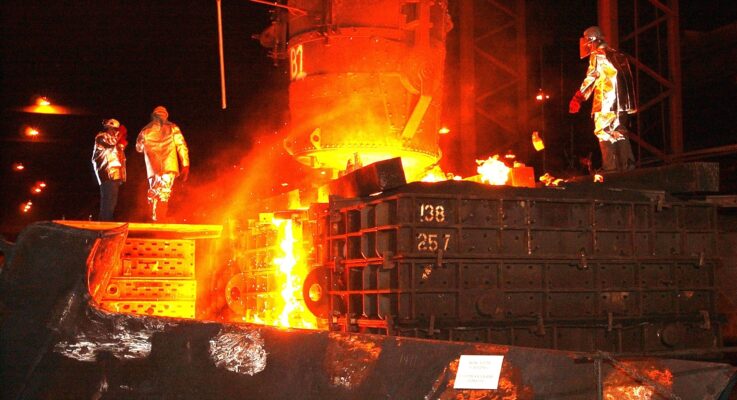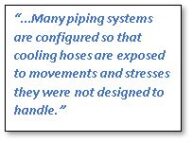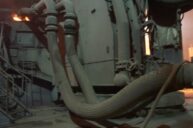Preventing Torque in Steel Mill Water Cooling Hoses
By: Frank Caprio | On: July 29, 2020

Water, water, every where,
Nor any drop to drink.
The Rime of the Ancient Mariner by Samuel Taylor Coleridge
 While the above excerpt describes the woeful state of the crew aboard their ill-fated vessel, it also applies to steelmaking. Water is everywhere. It is used for cooling the steel as well as the furnaces, casting units, and hot strip mills. Hoses and expansion joints are vital parts of these cooling systems, as they allow for movement of the equipment and accommodate stresses resulting from thermal expansion and contraction of the piping system. Unfortunately, many piping systems are configured so that cooling hoses are exposed to movements and stresses they were not designed to handle. Here are some ways to prevent torsion-related failures for water cooling lines.
While the above excerpt describes the woeful state of the crew aboard their ill-fated vessel, it also applies to steelmaking. Water is everywhere. It is used for cooling the steel as well as the furnaces, casting units, and hot strip mills. Hoses and expansion joints are vital parts of these cooling systems, as they allow for movement of the equipment and accommodate stresses resulting from thermal expansion and contraction of the piping system. Unfortunately, many piping systems are configured so that cooling hoses are exposed to movements and stresses they were not designed to handle. Here are some ways to prevent torsion-related failures for water cooling lines.
Don’t Twist the Cooling Hoses!
Hoses (metallic and non-metallic) are designed to handle various movements in a piping system, but twisting the hose assembly should be avoided. This is easier said than done, as there are numerous ways torque can be applied to a metal hose assembly:
1. Physically Twisting the Assembly While in Service

Cooling water hoses on an EAF roof with swivel joints attached
Often, torque is applied to the hose during cycling. This is a common occurrence in steel mills where furnace roof cooling hoses are twisted as the roof is removed prior to charging the furnace. These roofs can sway back and forth, twisting the hose in the process. The first thing to determine here is whether or not the hose can be installed in a plane of movement that avoids any torsional stresses. This will ensure maximum cycle life and avoid future issues. If torsion cannot be avoided, it is imperative that a swivel joint is used on one or both ends of the assembly to prevent twisting the hose. When specifying a swivel joint, select a “low-torque” style that is designed to be used with flexible hoses, and make sure it is well-maintained. We have seen applications where swivel joints designed for rigid pipe were attached to metal hoses, and the joints were so stiff that the hoses still twisted between the swivels! Also remember that torsion can be present in different planes, so make sure to select a swivel joint designed to accommodate movements in multiple planes if required.
2. Incorrect Installation

This hose was twisted during installation, leading to torsion during cycling
There are instances where the hose can be twisted as a result of improper installation. There are couple of ways this can happen. First, hoses with threaded end fittings can be inadvertently twisted during the final tightening of the connection. Second, hoses with flanged ends are sometimes twisted in order to align the bolt holes of the flanged hose end with the mating connections in the piping system. This problem is easily avoided by attaching “floating” flanges, which rotate on a stub end to allow proper flange alignment during installation.
3. Improper Hose Fabrication
The skill of the fabricator also has an effect on the service life of the assembly. If the braid is not applied straight and tight against the hose prior to welding, the hose may twist when the assembly is pressurized. This is one of many reasons why fabrication should only be performed by qualified personnel. Some fabricators may even promote using multiple sources for the hose and the braid to be incorporated in an assembly in order to keep costs down. Unfortunately, you get what you pay for, as safety and performance are often compromised if the assembly is made from mis-matched components.
4. System-related Issues
Even if a cooling hose is properly designed and installed, there are instances where pressure spikes or water hammer can damage and deform the corrugations. The hose may appear to be kinked when this occurs, potentially causing the assembly to be vulnerable to torsional stress if it is no longer aligned with the required movements.
Solving the Right Problem for Your Cooling Hoses
Eliminating torsional stresses is only one part of proper hose installation and usage. Other service conditions that can cause premature failures of cooling hoses include external abrasion, overbending, and corrosion. To help avoid all of these installation issues, we offer an Operations and Handling Manual for Metal Hose that is available for download from our website. One thing is for certain: each steel mill has its own “albatross” – challenges requiring innovative solutions – and that’s where we shine. Put our broad knowledge of metal hose and expansion joints to work. Contact us for assistance if we can help with on-site inspections, application advice, or engineering expertise.

